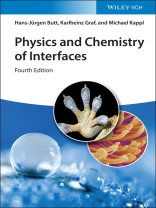This fourth edition has been fully updated and revised and covers new topics such as surface spectroscopies, non-equilibrium effects and novel coating methods, while retaining its proven concept of treating interface phenomena in a detailed and easily applicable manner.
Innehållsförteckning
1. Introduction2. Liquid Surfaces
2.1 Microscopic Picture of a Liquid Surface
2.2 Surface Tension
2.3 Equation of Young and Laplace
2.3.1 Curved Liquid Surfaces
2.3.2 Derivation of Young-Laplace Equation
2.3.3 Applying the Young-Laplace Equation
2.4 Techniques to Measure Surface Tension
2.5 Kelvin Equation
2.6 Capillary Condensation
2.7 Nucleation Theory
2.8 Summary
2.9 Exercises
3. Thermodynamics of Interfaces
3.1 Thermodynamic Functions for Bulk Systems
3.2 Surface Excess
3.3 Thermodynamic Relations for Systems with an Interface
3.3.1 Internal Energy and Helmholtz Energy
3.3.2 Equilibrium Conditions
3.3.3 Location of Interface
3.3.4 Gibbs Energy and Enthalpy
3.3.5 Interfacial Excess Energies
3.4 Pure Liquids
3.5 Gibbs Adsorption Isotherm
3.5.1 Derivation
3.5.2 System of Two Components
3.5.3 Experimental Aspects
3.5.4 Marangoni Effect
3.6 Summary
3.7 Exercises
4. Charged Interfaces and the Electric Double Layer
4.1 Introduction
4.2 Poisson-Boltzmann Theory of Diffuse Double Layer
4.2.1 Poisson-Boltzmann Equation
4.2.2 Planar Surfaces
4.2.3 The Full One-Dimensional Case
4.2.4 The Electric Double Layer around a Sphere
4.2.5 Grahame Equation
4.2.6 Capacitance of Diffuse Electric Double Layer
4.3 Beyond Poisson-Boltzmann Theory
4.3.1 Limitations of Poisson-Boltzmann Theory
4.3.2 Stern Layer
4.4 Gibbs Energy of Electric Double Layer
4.5 Electrocapillarity
4.5.1 Theory
4.5.2 Measurement of Electrocapillarity
4.6 Examples of Charged Surfaces
4.7 Measuring Surface Charge Densities
4.7.1 Potentiometric Colloid Titration
4.7.2 Capacitances
4.8 Electrokinetic Phenomena: the Zeta Potential
4.8.1 Navier-Stokes Equation
4.8.2 Electro-Osmosis and Streaming Potential
4.8.3 Electrophoresis and Sedimentation Potential
4.9 Types of Potential
4.10 Summary
4.11 Exercises
5. Surface Forces
5.1 Van der Waals Forces between Molecules
5.2 Van der Waals Force between Macroscopic Solids
5.2.1 Microscopic Approach
5.2.2 Macroscopic Calculation – Lifshitz Theory
5.2.3 Retarded Van der Waals Forces
5.2.4 Surface Energy and the Hamaker Constant
5.3 Concepts for the Description of Surface Forces
5.3.1 The Derjaguin Approximation
5.3.2 Disjoining Pressure
5.4 Measurement of Surface Forces
5.5 Electrostatic Double-Layer Force
5.5.1 Electrostatic Interaction between Two Identical Surfaces
5.5.2 DLVO Theory
5.6 Beyond DLVO Theory
5.6.1 Solvation Force and Confined Liquids
5.6.2 Non-DLVO Forces in Aqueous Medium
5.7 Steric and Depletion Interaction
5.7.1 Properties of Polymers
5.7.2 Force between Polymer-Coated Surfaces
5.7.3 Depletion Forces
5.8 Spherical Particles in Contact
5.9 Summary
5.10 Exercises
6. Contact Angle Phenomena and Wetting
6.1 Young’s Equation
6.1.1 Contact Angle
6.1.2 Derivation
6.1.3 Line Tension
6.1.4 Complete Wetting and Wetting Transitions
6.1.5 Theoretical Aspects of Contact Angle Phenomena
6.2 Important Wetting Geometries
6.2.1 Capillary Rise
6.2.2 Particles at Interfaces
6.2.3 Network of Fibers
6.3 Measurement of Contact Angles
6.3.1 Experimental Methods
6.3.2 Hysteresis in Contact Angle Measurements
6.3.3 Surface Roughness and Heterogeneity
6.3.4 Superhydrophobic Surfaces
6.4 Dynamics of Wetting and Dewetting
6.4.1 Spontaneous Spreading
6.4.2 Dynamic Contact Angle
6.4.3 Coating and Dewetting
6.5 Applications
6.5.1 Flotation
6.5.2 Detergency
6.5.3 Microfluidics
6.5.4 Electrowetting
6.6 Thick Films: Spreading of One Liquid on Another
6.7 Summary
6.8 Exercises
7. Solid Surfaces
7.1 Introduction
7.2 Description of Crystalline Surfaces
7.2.1 Substrate Structure
7.2.2 Surface Relaxation and Reconstruction
7.2.3 Description of Adsorbate Structures
7.3 Preparation of Clean Surfaces
7.3.1 Thermal Treatment
7.3.2 Plasma or Sputter Cleaning
7.3.3 Cleavage
7.3.4 Deposition of Thin Films
7.4 Thermodynamics of Solid Surfaces
7.4.1 Surface Energy, Surface Tension, and Surface Stress
7.4.2 Determining Surface Energy
7.4.3 Surface Steps and Defects
7.5 Surface Diffusion
7.5.1 Theoretical Description of Surface Diffusion
7.5.2 Measurement of Sur
Om författaren
Hans-Jürgen Butt is Director at the Max Planck Institute of Polymer Research in Mainz, Germany. He studied physics in Hamburg and Göttingen, Germany. Then he went to the Max-Planck-Institute of Biophysics in Frankfurt to work in Ernst Bamberg’s group. After receiving his Ph.D. in 1989 he went as a post-doc to Santa Barbara, California. From 1990-95 he spent as a researcher back in Germany at the Max-Planck-Institute for Biophysics. In 1996 he became associate professor for physical chemistry at the University Mainz, three years later full professor at the University of Siegen. Only two years later he joined the Max Planck Institute of Polymer Research in Mainz and became director for Experimental Physics. His research topics include Surface forces and wetting.Karlheinz Graf graduated at the Institute for Physical Chemistry in Mainz, and spent a postdoc at the University of California, Santa Barbara (UCSB). He has served as Project leader at the Max-Planck-Institute for Polymer Research, where his research concentrated on droplet evaporation, the structuring of polymer surfaces, and on constructing a special device for measuring forces between a solid surface and an adaptive lipid monolayer in a Langmuir trough. Afterwards he was acting Professor in Physical and Analytical Chemistry at the University of Siegen. After a short period at the University of Duisburg-Essen he became Professor for Physical Chemistry at the University of Applied Sciences (Hochschule Niederrhein) in Krefeld.
Michael Kappl studied physics at the University of Regensburg and the Technical University of Munich, and did his Ph D thesis work in Ernst Bamberg’s group at the Max Planck Institute of Biophysics in Frankfurt. After a year of postdoctoral research at the University of Mainz in the group of Prof. Butt, he worked as a consultant for Windows NT network solutions at the Pallas Soft AG, Regensburg. In 2000, he rejoined the group of Hans-Jürgen Butt. Since 2002 he is group leader at the Max Planck Institute for Polymer Research. By using focused ion beam methods, his investigates the adhesion and friction of micro- and nanocontacts, and capillary forces
Språk Engelska ● Formatera EPUB ● Sidor 480 ● ISBN 9783527836161 ● Filstorlek 39.6 MB ● Utgivare Wiley-VCH GmbH ● Publicerad 2023 ● Utgåva 4 ● Nedladdningsbara 24 månader ● Valuta EUR ● ID 8824800 ● Kopieringsskydd Adobe DRM
Kräver en DRM-kapabel e-läsare












